
Diary: The garden in May 2000

 | Diary: The garden in May 2000 |

|
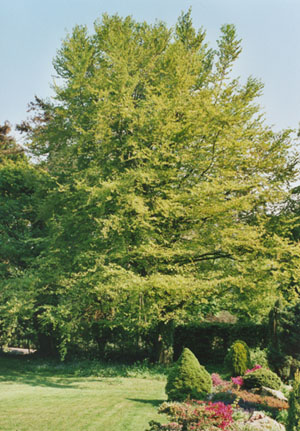 Buds on the re-trained outdoor grapevines are on the 1st showing signs of breaking. In the greenhouse the Black Hamburg has already produced flowerbuds which look like small bunches of grapes. The trusses of flowers are well distributed over the full length of the vine so there is the potential for a good crop. In a few days I will prune back the new shoots to a leaf just beyond the flowers. Non flowering shoots will thinned out and the best stopped at about the 4/5th leaf. These will bear next years' flowers. At the ends of the row of vines in the garden we have plants of hop Humulus lupulus and these have already strong shoots. The stems climb the end posts twisting in a clockwise direction, then along a wire well above the vines. They will meet in the middle, this year the hop at the north end seems to have an early advantage and may get most of the wire. The flowers of the hop are, of course, an important constituent used in brewing beer. Most of the trees in the wood and garden, and the shelterbelts around the fields are now in leaf. At this time of year there is a great variety of shades of green and the colours rival the autumn. Many of the trees are in flower, and with the fine weather, quantities of pollen have been accumulating on flat surfaces in the garden.
Buds on the re-trained outdoor grapevines are on the 1st showing signs of breaking. In the greenhouse the Black Hamburg has already produced flowerbuds which look like small bunches of grapes. The trusses of flowers are well distributed over the full length of the vine so there is the potential for a good crop. In a few days I will prune back the new shoots to a leaf just beyond the flowers. Non flowering shoots will thinned out and the best stopped at about the 4/5th leaf. These will bear next years' flowers. At the ends of the row of vines in the garden we have plants of hop Humulus lupulus and these have already strong shoots. The stems climb the end posts twisting in a clockwise direction, then along a wire well above the vines. They will meet in the middle, this year the hop at the north end seems to have an early advantage and may get most of the wire. The flowers of the hop are, of course, an important constituent used in brewing beer. Most of the trees in the wood and garden, and the shelterbelts around the fields are now in leaf. At this time of year there is a great variety of shades of green and the colours rival the autumn. Many of the trees are in flower, and with the fine weather, quantities of pollen have been accumulating on flat surfaces in the garden. 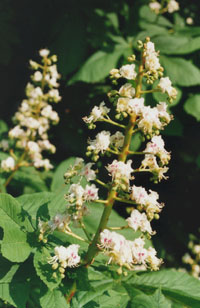 The flowers of horse chestnut trees are magnificent this year, we have several in the wood and one bordering the garden, and there are many more interspersed along the shelterbelts. Perhaps there will be a good harvest of conkers in the autumn. In a corner of the new flower border on the former vegetable plot I have set an old dustbin lid into the ground for the birds. Dustbin lids make handy birdbaths; the birds are very appreciative of water supplied in the garden for bathing and drinking. It is always worth providing water even if you do not feed, but site carefully in the open if cats are around. We now have 4 water stations, 2 in dustbin lids and 2 in water trays which are kept clean and supplied with fresh water. Often, not long after the water has been replaced, thrushes or blackbirds are having a bath! They must keep watch, as they seem to like the fresh water. Work on tilling the second half of the vegetable plot is also completed as the purple sprouting broccoli, seakale and leeks have been cleared. This half of the plot has had a layer of compost on it and incorporated using the MANTIS. On the flower borders, and elsewhere, buds of the Welsh poppy are opening. Patricia has been planting up the remainder of the new border as the outline is settled; I have finished the returfing at long last. This is a busy week as the garden will be open for the NSPCC Plant Sale on the 5-7th. We like the garden to be looking at its best, as visitors are welcome to have a look around. Home-grown plants to be included in the sale have been prepared. In addition we do have a lot of help from members of the local committee (Pentraeth, Llansadwrn, Llanbedrgoch and Rhoscefnhir). Many plants are arriving which have been grown by members and Lynne, from Pentraeth, has been organising the collection of those generously donated by local growers, nurseries and garden centres.
The flowers of horse chestnut trees are magnificent this year, we have several in the wood and one bordering the garden, and there are many more interspersed along the shelterbelts. Perhaps there will be a good harvest of conkers in the autumn. In a corner of the new flower border on the former vegetable plot I have set an old dustbin lid into the ground for the birds. Dustbin lids make handy birdbaths; the birds are very appreciative of water supplied in the garden for bathing and drinking. It is always worth providing water even if you do not feed, but site carefully in the open if cats are around. We now have 4 water stations, 2 in dustbin lids and 2 in water trays which are kept clean and supplied with fresh water. Often, not long after the water has been replaced, thrushes or blackbirds are having a bath! They must keep watch, as they seem to like the fresh water. Work on tilling the second half of the vegetable plot is also completed as the purple sprouting broccoli, seakale and leeks have been cleared. This half of the plot has had a layer of compost on it and incorporated using the MANTIS. On the flower borders, and elsewhere, buds of the Welsh poppy are opening. Patricia has been planting up the remainder of the new border as the outline is settled; I have finished the returfing at long last. This is a busy week as the garden will be open for the NSPCC Plant Sale on the 5-7th. We like the garden to be looking at its best, as visitors are welcome to have a look around. Home-grown plants to be included in the sale have been prepared. In addition we do have a lot of help from members of the local committee (Pentraeth, Llansadwrn, Llanbedrgoch and Rhoscefnhir). Many plants are arriving which have been grown by members and Lynne, from Pentraeth, has been organising the collection of those generously donated by local growers, nurseries and garden centres.

In the greenhouse on the 2nd the tomatoes were planted out into bags of compost laid on the soil surface. For the last 2 years they have been grown in the soil but this year it is bags. I have mixed feelings about this method of culture. Unless the soil can be sterilised, difficult in an amateur greenhouse, or dugout and replaced the dreaded 'tomato sickness' (a soil-borne fungal disease) will seriously diminish crops. I have used bags successfully in the past but watering is a problem. Irregular or over-watering can result in problems including blossom end rot. I am thinking of using again the bottomless pot method. In this method a bottomless pot filled with compost is placed on a gravel bed. The tomato planted in the pot roots through to the gravel that is kept well watered. The plant develops 2 root systems, one in the pot and the other in the gravel. After planting minimal watering of the pot is done so that the tomato roots through to the gravel. Liquid feed is applied to the pot at intervals after 1 month of growth. 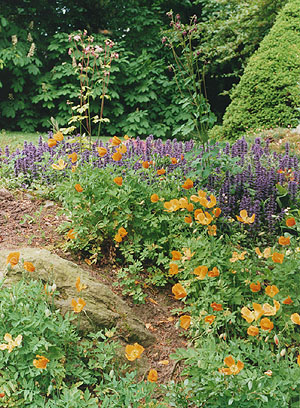 This system works much better than bags and can if necessary be left several days without watering. Watering the gravel bed is quicker and requires much less care or technical expertise than the bags. Well, perhaps next year! On the 4th 2 pairs of goldfinches were seen together in the garden. They must be nesting here as later one pair was collecting nesting material from the rockery. They seemed particularly interested in roots and spent a long time trying to pull up rather too well attached roots. I think they got some in the end. Since the beginning of the month it has been warmer and much drier. No rain so far so that work can be carried out at any time. I sowed 2 rows of peas on the 6th. We have grown Onward for many years and lately the Oregon Mangetout; you can eat the whole pod when young. For the last 2 seasons we have grown instead the Sugar Snap var. Gem that we find we prefer. Between the rows of peas I grow a row (comprising 3 or 4 lines) of broad beans (saved seed from an old dwarf variety The Sutton). The beans grow well between the peas and, being a dwarf variety, are given good shelter from the winds and no staking is required. I used to use the traditional pea sticks set neatly along the rows of peas; the sticks were functional and looked nice in the row but were always difficult to obtain. I have since devised a system using polythene netting held in an A-frame on metal stakes. It is put in position after sowing and at the end of the season rolled up and stored for the following year. I also planted 2 rows of lettuces that had been grown in the greenhouse in modules and have been hardened off in the cold frame. A row on the vegetable plot is about 6.5 m long.
This system works much better than bags and can if necessary be left several days without watering. Watering the gravel bed is quicker and requires much less care or technical expertise than the bags. Well, perhaps next year! On the 4th 2 pairs of goldfinches were seen together in the garden. They must be nesting here as later one pair was collecting nesting material from the rockery. They seemed particularly interested in roots and spent a long time trying to pull up rather too well attached roots. I think they got some in the end. Since the beginning of the month it has been warmer and much drier. No rain so far so that work can be carried out at any time. I sowed 2 rows of peas on the 6th. We have grown Onward for many years and lately the Oregon Mangetout; you can eat the whole pod when young. For the last 2 seasons we have grown instead the Sugar Snap var. Gem that we find we prefer. Between the rows of peas I grow a row (comprising 3 or 4 lines) of broad beans (saved seed from an old dwarf variety The Sutton). The beans grow well between the peas and, being a dwarf variety, are given good shelter from the winds and no staking is required. I used to use the traditional pea sticks set neatly along the rows of peas; the sticks were functional and looked nice in the row but were always difficult to obtain. I have since devised a system using polythene netting held in an A-frame on metal stakes. It is put in position after sowing and at the end of the season rolled up and stored for the following year. I also planted 2 rows of lettuces that had been grown in the greenhouse in modules and have been hardened off in the cold frame. A row on the vegetable plot is about 6.5 m long. 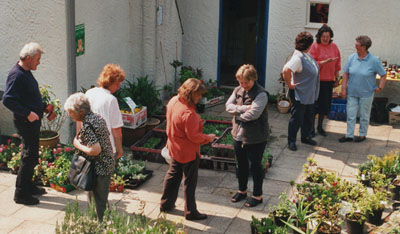 The first day of the NSPCC Plant Sale on the 5th is dry and sunny. This is a big advantage and final preparations start early for the opening at 2pm. Lynne has been busy for a while putting up posters in local shops, but it is my job to put up notices at both ends of the road and outside the house. The weather continued fine and sunny over the weekend and in all over £600 was raised.
The first day of the NSPCC Plant Sale on the 5th is dry and sunny. This is a big advantage and final preparations start early for the opening at 2pm. Lynne has been busy for a while putting up posters in local shops, but it is my job to put up notices at both ends of the road and outside the house. The weather continued fine and sunny over the weekend and in all over £600 was raised.
On the 7th the warmth had brought out more rhododendron flowers but not uniformly so on all bushes. 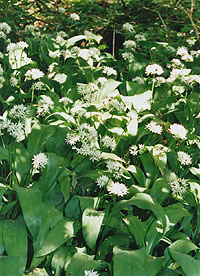 In the wood the white flowered wild garlic is in flower in quite dense patches. The familiar garlic smell lingers in the air for a long time after walking nearby. On the rockeries more of the orange Welsh poppies have come out, they are very good this year. On one large plant I counted over 50 flowers and there were many buds still to open. In one part of the rockery bank a swathe of orange Welsh poppies joins a large 2-3 m patch of bugle Ajuga reptans. This enjoys a semi-shaded position under a pine that has grown rather too large for the rockery. We are reluctant to remove it at present so have removed it lower branches. Despite this it still looks very well and it has had a reprieve. It is now useful for hanging bird feeders on the lower branches and at present has also the cotton bale.
In the wood the white flowered wild garlic is in flower in quite dense patches. The familiar garlic smell lingers in the air for a long time after walking nearby. On the rockeries more of the orange Welsh poppies have come out, they are very good this year. On one large plant I counted over 50 flowers and there were many buds still to open. In one part of the rockery bank a swathe of orange Welsh poppies joins a large 2-3 m patch of bugle Ajuga reptans. This enjoys a semi-shaded position under a pine that has grown rather too large for the rockery. We are reluctant to remove it at present so have removed it lower branches. Despite this it still looks very well and it has had a reprieve. It is now useful for hanging bird feeders on the lower branches and at present has also the cotton bale. 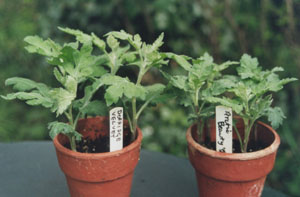 On the 10th I planted 3 rows of potatoes. We no longer grow early potatoes because of the reduced size of plot. This may seem strange, as the first potatoes always taste the best. Our reasoning was that we are particularly partial to a late variety Pink fur apple. We have grown this potato, for several years now, soon after it was re-discovered and again made commercially available. Two rows were the minimum we wanted to grow, that left 1 row spare. In this row we grow a potato which is grown a lot in France, we do not know the variety. It is a mid season potato which grows very well here. For our early potatoes we go along the road to Llanbedrgoch where a farmer grows early potatoes under polythene and every year sells at the roadside. This year we purchased the first available 5 days ago on the 5th! We could not compete with this. The roadside verges along the main roads are now being mowed. This should only be done on main roads this early, and restricted to a strip along the road edge and at junctions. It is too early to cut the banks and country lanes where there are numerous flowering plants and nesting birds. We were pleased to see that a stretch of road near Brynsiencyn had not been cut, because there were early purple orchids growing. It was marked out with stakes, full marks to whoever organised this. We have caught sight of the first spotted flycatcher flitting about. These can be rather shy when they first arrive but are seen more often later on. They sometimes also use the electricity cable to perch on while waiting to catch insects on the wing. Returning to the perch time and time again. One year a pair set up nest in the roof gutter beneath the bathroom window, but they usually nest on a branch of a tree.
On the 10th I planted 3 rows of potatoes. We no longer grow early potatoes because of the reduced size of plot. This may seem strange, as the first potatoes always taste the best. Our reasoning was that we are particularly partial to a late variety Pink fur apple. We have grown this potato, for several years now, soon after it was re-discovered and again made commercially available. Two rows were the minimum we wanted to grow, that left 1 row spare. In this row we grow a potato which is grown a lot in France, we do not know the variety. It is a mid season potato which grows very well here. For our early potatoes we go along the road to Llanbedrgoch where a farmer grows early potatoes under polythene and every year sells at the roadside. This year we purchased the first available 5 days ago on the 5th! We could not compete with this. The roadside verges along the main roads are now being mowed. This should only be done on main roads this early, and restricted to a strip along the road edge and at junctions. It is too early to cut the banks and country lanes where there are numerous flowering plants and nesting birds. We were pleased to see that a stretch of road near Brynsiencyn had not been cut, because there were early purple orchids growing. It was marked out with stakes, full marks to whoever organised this. We have caught sight of the first spotted flycatcher flitting about. These can be rather shy when they first arrive but are seen more often later on. They sometimes also use the electricity cable to perch on while waiting to catch insects on the wing. Returning to the perch time and time again. One year a pair set up nest in the roof gutter beneath the bathroom window, but they usually nest on a branch of a tree. 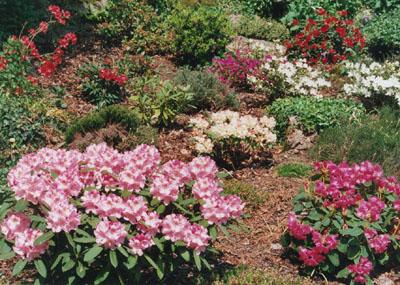 The warm and dry weather still continues and on the 11th the rhododendrons and azaleas seemed at their best. Most blooms are fully open and we are very pleased with the overall result. Preparations for the rhododendron garden were started 5 years ago and we have been planting for about 3 years. This is the first season in which all the new plants have flowered more or less at the same time. Now that the Plant Sale is over for another year Patricia has been tidying up in the greenhouse. Already thought is being given to what plants to propagate and stock plants are being looked at with this in mind. I have been potting up the chrysanthemum plants, which have been hardened off in the frames. The plants are potted in 10in plastic pots and stood on a solid base path along the greenhouse. It is essential here to have the pots on a firm base as, with the winds we get, unstable pots are easily blown over. I pot up firmly in our own-composted soil and tie in to a single cane. At intervals during the season I will feed with liquid fertiliser. Our sweet pea plants, grown in the greenhouse in tall pots, and hardened off in the cold frame were planted out on the 12th. They are grown in a line up a wire netting on an 8ft high pole structure along one side of the vegetable plot. We spotted the female pheasant with one small chick on the drive near the house. They disappeared into the undergrowth. The 13th is starting the 14th day with any rain. The garden is looking very dry on the surface and is excellent for hoeing off weeds. These dry and die within hours, a luxury we do not often have here being normally rather wet! Soil underneath is still moist; it was not long ago that the soils were saturated with water and most plants are adequately supplied. The lawn grass is growing well and needs mowing at weekly intervals. The grass under the trees, which until now has been growing only slowly, has put on a spurt and now needs mowing weekly as well.
The warm and dry weather still continues and on the 11th the rhododendrons and azaleas seemed at their best. Most blooms are fully open and we are very pleased with the overall result. Preparations for the rhododendron garden were started 5 years ago and we have been planting for about 3 years. This is the first season in which all the new plants have flowered more or less at the same time. Now that the Plant Sale is over for another year Patricia has been tidying up in the greenhouse. Already thought is being given to what plants to propagate and stock plants are being looked at with this in mind. I have been potting up the chrysanthemum plants, which have been hardened off in the frames. The plants are potted in 10in plastic pots and stood on a solid base path along the greenhouse. It is essential here to have the pots on a firm base as, with the winds we get, unstable pots are easily blown over. I pot up firmly in our own-composted soil and tie in to a single cane. At intervals during the season I will feed with liquid fertiliser. Our sweet pea plants, grown in the greenhouse in tall pots, and hardened off in the cold frame were planted out on the 12th. They are grown in a line up a wire netting on an 8ft high pole structure along one side of the vegetable plot. We spotted the female pheasant with one small chick on the drive near the house. They disappeared into the undergrowth. The 13th is starting the 14th day with any rain. The garden is looking very dry on the surface and is excellent for hoeing off weeds. These dry and die within hours, a luxury we do not often have here being normally rather wet! Soil underneath is still moist; it was not long ago that the soils were saturated with water and most plants are adequately supplied. The lawn grass is growing well and needs mowing at weekly intervals. The grass under the trees, which until now has been growing only slowly, has put on a spurt and now needs mowing weekly as well. 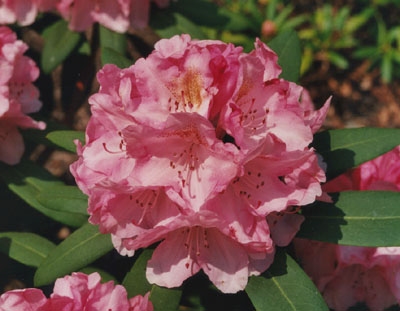 We have in recent days once watered the rhododendrons and azaleas, which are still in full bloom. As these are recently planted, and having rather compact root systems, they needed to be kept moist. Rain has been forecast and fell overnight, but only amounted to 0.2 mm, and did not wet the soil surface. The dry surface soil could pose a problem for nest-building swallows and house martins. They depend on mud for nest repair and building. We do not have nests on our house, the birds we see nest in and on the farm buildings just up the road. It is likely that they can find enough soft mud churned up by farm vehicles or in wet ditches bordering some fields. The 14th, the warmest day we have had this year, was a day to enjoy the garden so no work was done. We were pleased to see that a pair of blue tits was making frequent visits to one of the new nest boxes. They were taking in aphids and small grubs collected from the trees nearby to feed their brood. As one of the pair arrived with a beakful, and perched on a snowberry twig, it would make a sound and wait for the other to emerge before entering the box. They did not seem to mind our presence, sitting nearby, as they carried on feeding. The male goldfinches have been singing a lot; one will sometimes perch on the electricity supply cable near the house. It has a quiet but complex and beautiful canary-like song. Plants on our small alpine rockery, on a well-drained steep terraced bank, are looking good. There are several varieties of saxifrage in flower together with roseroot Sedum rosea and alpine Lady's-mantle Alchemilla alpina. Lamb's tail Chriastophyllum oppositifolium has been in flower for a while. This seeds itself readily and is best when it pops up in cracks between the rocks. It enjoys cool partial shade so is possibly a reason why it does so well here. The very hardy thrifts (or sea pinks) Armeria maritima are also just starting to flower. One pink thrift, with its grassy mat, has almost taken over a rock and looks most natural. We also have a pure white variety Alba, but this is not so vigorous. This reminds me that it is time to pay a visit to Point Lynas at the NE corner of Anglesey. This is worth a visit at any time of the year, but is particularly so in the spring and early summer when the thrifts are in bloom. Go there if you can!
We have in recent days once watered the rhododendrons and azaleas, which are still in full bloom. As these are recently planted, and having rather compact root systems, they needed to be kept moist. Rain has been forecast and fell overnight, but only amounted to 0.2 mm, and did not wet the soil surface. The dry surface soil could pose a problem for nest-building swallows and house martins. They depend on mud for nest repair and building. We do not have nests on our house, the birds we see nest in and on the farm buildings just up the road. It is likely that they can find enough soft mud churned up by farm vehicles or in wet ditches bordering some fields. The 14th, the warmest day we have had this year, was a day to enjoy the garden so no work was done. We were pleased to see that a pair of blue tits was making frequent visits to one of the new nest boxes. They were taking in aphids and small grubs collected from the trees nearby to feed their brood. As one of the pair arrived with a beakful, and perched on a snowberry twig, it would make a sound and wait for the other to emerge before entering the box. They did not seem to mind our presence, sitting nearby, as they carried on feeding. The male goldfinches have been singing a lot; one will sometimes perch on the electricity supply cable near the house. It has a quiet but complex and beautiful canary-like song. Plants on our small alpine rockery, on a well-drained steep terraced bank, are looking good. There are several varieties of saxifrage in flower together with roseroot Sedum rosea and alpine Lady's-mantle Alchemilla alpina. Lamb's tail Chriastophyllum oppositifolium has been in flower for a while. This seeds itself readily and is best when it pops up in cracks between the rocks. It enjoys cool partial shade so is possibly a reason why it does so well here. The very hardy thrifts (or sea pinks) Armeria maritima are also just starting to flower. One pink thrift, with its grassy mat, has almost taken over a rock and looks most natural. We also have a pure white variety Alba, but this is not so vigorous. This reminds me that it is time to pay a visit to Point Lynas at the NE corner of Anglesey. This is worth a visit at any time of the year, but is particularly so in the spring and early summer when the thrifts are in bloom. Go there if you can! 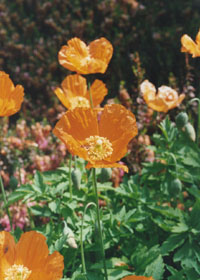 By the 15th the row of Onward peas, planted on the 6th, have germinated. We have been seeing several damsel flies around the garden. Some have brown bodies and others dark blue. Sometimes we see the larger dragon fly, but usually later in the year. I think we could do more to encourage these by having a pond. A project for the future perhaps! This week has seen several more raids on the rookery by a buzzard. The buzzard seems to have adopted a new strategy. Instead of coming in high it makes a low level approach, but is still spotted by the rooks and driven off noisily usually through the garden. This has been done by as few as 5 or as many as we estimate 30-50 rooks. The 16th has brought some welcome rain, which seems to be appreciated by the thrushes and blackbirds, busy collecting food for their young. During the dry weather they have been increasingly searching under the fallen leaves under bushes and in the wood. Today after the rain there have been pairs of blackbirds and song thrushes quartering the lawns. It is interesting to see where they are taking their catches; there is a blackbird and a song thrush nest in the wide, and now dense, hedge near the kitchen. There is also at least one nest of sparrow and greenfinch as well. This hedge always does well; we call it the 'apartment block', as it is a popular, relatively safe from predators home for so many birds. Originally an evergreen laurel hedge, at the entrance to the former Gadlys estate, had deteriorated over the years and we have interplanted it with the woody climber honeysuckle Lonicera spp. and a creamy-pink vanilla scented Clematis montana a cutting from an original plant from the 1960's and the rosy-pink Rubens.
By the 15th the row of Onward peas, planted on the 6th, have germinated. We have been seeing several damsel flies around the garden. Some have brown bodies and others dark blue. Sometimes we see the larger dragon fly, but usually later in the year. I think we could do more to encourage these by having a pond. A project for the future perhaps! This week has seen several more raids on the rookery by a buzzard. The buzzard seems to have adopted a new strategy. Instead of coming in high it makes a low level approach, but is still spotted by the rooks and driven off noisily usually through the garden. This has been done by as few as 5 or as many as we estimate 30-50 rooks. The 16th has brought some welcome rain, which seems to be appreciated by the thrushes and blackbirds, busy collecting food for their young. During the dry weather they have been increasingly searching under the fallen leaves under bushes and in the wood. Today after the rain there have been pairs of blackbirds and song thrushes quartering the lawns. It is interesting to see where they are taking their catches; there is a blackbird and a song thrush nest in the wide, and now dense, hedge near the kitchen. There is also at least one nest of sparrow and greenfinch as well. This hedge always does well; we call it the 'apartment block', as it is a popular, relatively safe from predators home for so many birds. Originally an evergreen laurel hedge, at the entrance to the former Gadlys estate, had deteriorated over the years and we have interplanted it with the woody climber honeysuckle Lonicera spp. and a creamy-pink vanilla scented Clematis montana a cutting from an original plant from the 1960's and the rosy-pink Rubens. 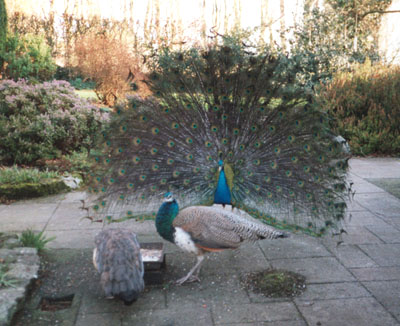 The honeysuckle soon developed, but the clematis have been slow to develop possibly because they like a more calcareous soil. This year the vanilla scented clematis has plenty of flowers facing south towards the drive entrance and there are buds of the Rubens on the north side of the hedge. The 17th was cold and wet and brought work in the garden to a halt. The flowers of the Welsh poppies were looking sad after their good display over the last weeks, the earliest starting to drop petals. They are very robust plants, used to the mountain habitat, and respond to humidity by closing and hanging their flower heads. Given dry and sunny weather again they will, together with any yet unopened buds, give more pleasure over the coming weeks.
The honeysuckle soon developed, but the clematis have been slow to develop possibly because they like a more calcareous soil. This year the vanilla scented clematis has plenty of flowers facing south towards the drive entrance and there are buds of the Rubens on the north side of the hedge. The 17th was cold and wet and brought work in the garden to a halt. The flowers of the Welsh poppies were looking sad after their good display over the last weeks, the earliest starting to drop petals. They are very robust plants, used to the mountain habitat, and respond to humidity by closing and hanging their flower heads. Given dry and sunny weather again they will, together with any yet unopened buds, give more pleasure over the coming weeks.
Last year, for the first time for many, there were almost no poppies in the garden. Visitors asked, "What is different about the garden?" The plants were there but no flowers. The explanation was that peacocks had eaten the flower buds. A male peacock (we called him Percy) turned up in the garden in April 1996 and was attracted to the bird feeding stations. He became a regular visitor and at night roosted high in the trees. He remained during 1997 surviving the gales, cold winter weather and road traffic, and became quite a character around the area. He was still here in 1998 when, in May, a female appeared. It is likely that someone, who probably thought it a "good idea", introduced the female (we called her Penny). Nature took its course. Of a good clutch of eggs produced only one male chick survived the wet weather and turned up in the garden. The chick survived the summer, including sparrowhawk attacks, and the following winter.  In the spring of 1999, the female and male chick, now almost fully grown but without the proper colouring and large tail feathers, were still inseparable. But the female now had other ideas and went off to nest. At least two failed attempts at nesting took place. At a final attempt the female did not return and was not seen again. Peacocks, like pheasants, nest on the ground and are vulnerable to predation by foxes. It is possible that this happened but now seems unlikely. The two males (Percy and Perry) continued visiting the garden nearly every day for food until the middle of January 2000. Both birds came for food one day and they have not been seen again. "Foul play" is suspected, as it is most unlikely that 2 male birds would fall to natural predation at the same time. During the day at any sign of trouble, say dogs, the birds would fly up to the trees.
In the spring of 1999, the female and male chick, now almost fully grown but without the proper colouring and large tail feathers, were still inseparable. But the female now had other ideas and went off to nest. At least two failed attempts at nesting took place. At a final attempt the female did not return and was not seen again. Peacocks, like pheasants, nest on the ground and are vulnerable to predation by foxes. It is possible that this happened but now seems unlikely. The two males (Percy and Perry) continued visiting the garden nearly every day for food until the middle of January 2000. Both birds came for food one day and they have not been seen again. "Foul play" is suspected, as it is most unlikely that 2 male birds would fall to natural predation at the same time. During the day at any sign of trouble, say dogs, the birds would fly up to the trees.  They of course would roost in the trees at night. The peacocks were of interest to many people in the area; some said how they liked them and were now a feature of Gadlys. Unfortunately they were not liked by all; it is probable that they were removed by one means or another. Of course anyone who might know their fate is keeping very quiet about the whole affair! The peacocks appeared to do little damage in the garden; we were always surprised how they picked their way between the plants when hunting insects. They will eat plants, and it was necessary to protect the vegetable plot with wire netting. One plant they took a liking to was the Welsh poppy. Percy would eat the seedpods when ripe, but sufficient seed would fall to the ground for new plants to grow next season. Penny and Perry, however, took a liking to the plant itself. At first all seemed well, the whole plant was not eaten and we thought they were just pecking pieces of the leaves. But what they were going for were the flower buds. We had no poppies in 1999! We are sorry they have gone; they would have featured regularly in this diary.
They of course would roost in the trees at night. The peacocks were of interest to many people in the area; some said how they liked them and were now a feature of Gadlys. Unfortunately they were not liked by all; it is probable that they were removed by one means or another. Of course anyone who might know their fate is keeping very quiet about the whole affair! The peacocks appeared to do little damage in the garden; we were always surprised how they picked their way between the plants when hunting insects. They will eat plants, and it was necessary to protect the vegetable plot with wire netting. One plant they took a liking to was the Welsh poppy. Percy would eat the seedpods when ripe, but sufficient seed would fall to the ground for new plants to grow next season. Penny and Perry, however, took a liking to the plant itself. At first all seemed well, the whole plant was not eaten and we thought they were just pecking pieces of the leaves. But what they were going for were the flower buds. We had no poppies in 1999! We are sorry they have gone; they would have featured regularly in this diary.
We saw a pair of hares in the field by the house in the evening of the 23rd. They appear in the fields from time to time and we have had them in the garden and wood. They are difficult to spot, unless they move or are close by the window, as they can be hidden in undulations in the ground or behind longer grass. We are lucky to see them so often as they are now quite rare in some places. In recent days we have seen the pair of pheasants but without their chick. We assume the chick did not survive. On a walk around the lanes on the 27th the hedgerows were in places full of colourful pink campions and yellow buttercups. Some of the grassy areas below the banks and walls were disappointing, being dominated by the tall cow parsley. The hawthorn was still flowering and the blackberries, cut back by the mechanical hedge cutters in the autumn, were already producing new growth. Near the end of the walk is an uncultivated marshy corner of a field. Over the years many such damp areas have been drained; I look every year to see if this patch has survived and I was not disappointed. Several patches of the yellow Iris pseudacorus were in flower amongst buttercups. In the garden, in the herbaceous border, we have a rather fine clump of the small flowered blue Iris sibirica. Also coming into flower are several colourful lupins. The 29th was a sunny day and, sitting near the new nest box we saw that the blue tits were still feeding their young. As well as natural food, from time to time, we noticed that they were also bringing crumbs of bread put out on one of out feeding trays. We always moisten the bread, as recommended, before putting it out for the birds. Perhaps if we are lucky we may see the nestlings emerge in a day or two.
Document dated: 30 May 2000. This page is part of the site maintained at http://www.llansadwrn-wx.co.uk
Copyright ©: 2000 Donald and Patricia Perkins